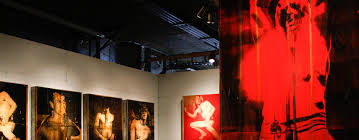
Artist Skylar Fein was walking through New Orleans' French Quarter a few years ago when he passed by a plaque that read "On this spot these 32 people died when a gay bar was set on fire." "I looked up and felt a chill.... I wanted to know the story," Fein told us in a recent email interview about "Remember the UpStairs Lounge," his current No Longer Empty instillation about the gay bar destroyed by a 1973 arson fire. The fire killed 32 people, injured 20, and, after a brief run of sensationalized local media coverage, was mostly forgotten about. Bellow, Fein discusses the exhibit -- which includes crime scene photographs, police reports, salvaged items from the bar, and signs and decor created by the artist -- the mark the tragedy left on the gay community, and why the fire at the UpStairs Lounge shouldn't be forgotten.
Was the fact that this case is unsolved inspiring to you?
That made it more interesting. Gaps give a storyteller room to work. It's worth noting that the main suspect -- who was almost certainly a gay man -- was never charged, and that he killed himself a year after the fire: overdose of barbiturates. It's true that the police did an investigation and couldn't find any solid evidence tying him to the fire. But let's be honest. Had the fire been in, say, Galatoire's restaurant a few blocks away, and had it killed dozens of rich, white, heterosexuals, the arsonist would never have walked. The cops would have 'planted' evidence in order to jail him. That's how it worked then, and how it works now, at least some of the time.
What was New Orleans' media's take on the fire?
Local news treated the story as a pulpy pot-boiler. The serious newspaper accounts referred to the smell of burning meat and bodies 'stacked like pancakes.' The dead men and women were disposable; they were refuse that had been incinerated. Again, do the Galatoire's thought experiment. It is impossible to imagine the dead being described so luridly.
What was the response to this show when it first ran in New Orleans in 2008?
Here's a big admission: I thought the UpStairs Lounge was one big AIDS metaphor. It's the 1970s, and a whole roomful of gay men just disappear. And nobody cares. What does this remind you of? I thought the parallel to AIDS was so obvious as to be heavy handed, and I was careful not to mention AIDS in the installation, since I didn't want to belabor the obvious. So, in the course of the original run, how many visitors mentioned AIDS to me? Exactly zero. What people did mention was Hurricane Katrina, another time that certain people were written off. They mentioned the time they were in the hospital, or the time their brother came back from prison. Some people get left out, left behind, even left for dead, and sometimes it's you.
How did the fire affect New Orleans' gay community at the time?
Stewart Butler, who left the bar minutes before the fire, and who went on to become one of New Orleans' chief gay organizers, said to me with some disbelief,'Why are you interested in this story, in this senseless tragedy from which no good came?' That's one school of thought. But then again, didn't Stewart Butler go on to become a powerful community organizer, founder of nonprofits, leader of marches and protests? And couldn't that have had something to do with the fire? I'll never know. Most people agree that the real boost to the gay community in New Orleans came in the form of entertainer Anita Bryant, who stopped off there on a national anti-gay speaking tour a few years after the fire. She provided the gay community with a ready enemy, and many people say her visit had a galvanic effect. Taking a wide view, I'd say the fire and the Anita Bryant visit were a one-two punch; the fire showed the need for advocacy, and Anita Bryant lit the fuse.
Did survivors of the fire, or those who knew people killed, ask you not to create this exhibit?
There were some older gay men who were not happy with the exhibit. The gist of their argument: in all of gay history, why highlight this low moment, in which we killed each other? Why air this dirty laundry? Why not pick something clean, scrubbed, uplifting? The sarcastic me has suggested that they start their own exhibition, 'the Happy Museum of Gay History,' featuring Liza with a Z and other stirring moments. The introspective me, on the other hand, looks to them with compassion. They are sharing their pain -- the pain of being gay at another time -- with me, who's from another generation, and who doesn't know that pain precisely because of their sacrifice! I was talking with my exhibition designer, Joel Crispin Brotherton, about all this. And he thought for a while and he said, 'We are the answer to their prayers.'